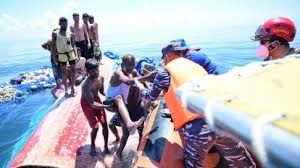Geography: March 2024 UPSC Current Affairs | Current Affairs & Hindu Analysis: Daily, Weekly & Monthly PDF Download
| Table of contents |

|
| Surge in Demand of Copper |

|
| India Joins Sri Lanka in Seabed Mining Race |

|
| Menace of Illegal Migration |

|
| Black Sea |

|
| Integrated River Basin Management |

|
Surge in Demand of Copper

Why is Copper in the Spotlight?
With a 16% year-on-year increase in demand for copper in FY23, policymakers and corporations are recognizing its pivotal role in driving economic growth.
Key Insights into Copper
- Characteristics: Known for its malleability, ductility, excellent heat and electricity conductivity, corrosion resistance, and antimicrobial properties.
- Malleability: Ability to be pressed or rolled into thin sheets without breaking.
- Ductility: Ability to be stretched into thin wires without losing strength.
- Applications: Widely used in construction, consumer durables, transportation, and industrial manufacturing. Integral to clean energy technologies like solar panels, electric vehicles, and energy-efficient motors. Fully recyclable, enabling a circular economy.
- Occurrence and Composition: Naturally found in various forms in the Earth’s crust, with most commercial deposits containing an average grade of 0.8% copper.
- Mining Methods: Primarily through open-pit and underground mining, with open-pit operations dominating 80% of global copper mining.
- Copper Deposits in India: Mainly concentrated in districts like Singhbhum (Jharkhand), Balaghat (Madhya Pradesh), and Jhunjhunu and Alwar (Rajasthan).
- India's Growing Demand: Driven by infrastructure projects, renewable energy initiatives, and urbanization. Despite high demand, India heavily relies on imports due to limited domestic reserves.
- Government Initiatives: Promoting investments in smelters and refineries, acquiring copper mines abroad, and exploring opportunities in countries like Zambia. Recognizing copper as a critical mineral to reduce import dependence.
- Role of Hindustan Copper Limited (HCL): Established in 1967 under the Ministry of Mines, it's India's sole vertically integrated copper producer.
- Copper's Economic Significance: Acts as a global economic indicator due to its price sensitivity to demand/supply dynamics, monetary markets, and speculation. Integral to energy efficiency in buildings, contributing to reduced energy consumption for heating, cooling, and lighting.
India Joins Sri Lanka in Seabed Mining Race
Why in News?
India has recently requested authorization to investigate the seabed of the Indian Ocean outside its usual boundaries, which includes the cobalt-rich Afanasy Nikitin Seamount (AN Seamount). India's motivation for this request is driven by worries about Chinese vessels conducting surveillance activities in the area.
- The rights to this region have already been asserted by Sri Lanka through a distinct legal framework.
What is Afanasy Nikitin Seamount (AN Seamount)?
- The AN Seamount is a structural feature (400 km long and 150 km wide) in the Central Indian Basin, located about 3,000 km away from India’s coast.
- From an oceanic depth of about 4,800 km, it rises to about 1,200 meters and it is rich in deposits of cobalt, nickel, manganese and copper.
- To proceed with extraction, interested parties/countries must first apply for an exploration license to the International Seabed Authority (ISBA). This organisation operates autonomously under the United Nations Convention on the Law of the Sea (UNCLOS).
- These rights are specific to areas that are part of the open ocean. Around 60% of the world’s seas are open ocean and though believed to be rich in a variety of mineral wealth, the costs and challenges of extraction are prohibitive.
What is Deep Sea Bed Mining?
- Deep-sea mining involves extracting valuable mineral deposits from the ocean floor at depths ranging from 200 to 6,500 meters below the surface.
- These mineral deposits include materials such as copper, cobalt, nickel, zinc, silver, gold, and rare earth elements.
- NIO has tested deep-sea mining systems up to 512 meters depth and is working on systems for up to 6,000 meters.
- Establishing deep-sea mines was earlier considered more expensive than land-based mining.
- Innovations in underwater robotics from the petroleum industry have improved prospects for deep-sea mining.
What are the Continental Shelf Claims and Exploration Rights?
- Exclusive Rights to Continental Shelf: Nations possess exclusive rights within 200 nautical miles from their coastlines, covering the seabed beneath. This authority encompasses the exploration and potential utilization of resources within this region.
- Continental Shelf Extension: Some coastal states may have a natural land formation linking their territory to the outer edge of the deep sea, surpassing the 200-nautical-mile boundary. This extension is referred to as the continental shelf.
- Special Provisions: Certain regulations allow countries bordering the Bay of Bengal to employ different criteria for asserting claims over the extent of their continental shelf.
- Example: Sri Lanka, utilizing one such provision, has staked a claim for an extension of its continental shelf to 500 nautical miles, exceeding the standard limit of 350 nautical miles.
- Rational Support for Claims: To assert exclusive rights to the continental shelf beyond 200 nautical miles, a nation must furnish a comprehensive scientific justification backed by underwater mappings and surveys. This data is submitted to a scientific committee appointed by the International Seabed Authority (ISBA).
- Upon approval by the committee, the country gains precedence to explore and potentially exploit both biological and mineral resources within the extended continental shelf.
What is the Significance of Deep Sea Mining?
- Resource Accessibility: Deep-sea mining offers access to precious resources that are increasingly scarce on land. These resources include polymetallic nodules, polymetallic sulfides, and cobalt-rich ferromanganese crusts, which contain high concentrations of minerals like copper, nickel, cobalt, and rare earth elements. As terrestrial deposits dwindle, deep-sea mining emerges as an alternative source for these crucial materials.
- Technological Advancements: The development of technologies for deep-sea mining presents opportunities for innovation and technological progress. This involves the creation of specialized equipment capable of functioning in harsh oceanic conditions, such as high pressure, darkness, and low temperatures. Advancements in robotics, remotely operated vehicles (ROVs), and autonomous underwater vehicles (AUVs) are indispensable for efficient and safe mining operations.
- Economic Potential: Deep-sea mining holds significant economic promise for participating nations and companies. The extraction of valuable minerals from the ocean floor can spur economic development, generate employment opportunities, and contribute to national revenue through taxes, royalties, and resource-sharing agreements.
What are the Concerns Related to Deep Sea Mining?
- Damage to Marine Ecosystem: Deep-sea mining poses a threat to marine ecosystems. Mining activities can cause disturbances such as noise, vibration, and light pollution, along with potential leaks and spills of fuels and chemicals used in the process. Such activities have the potential to significantly harm marine biodiversity and ecosystems.
- Sediment Plume Formation: Deep-sea mining can result in the stirring up of fine sediments on the seafloor, leading to the creation of suspended sediment plumes. After valuable materials are extracted, slurry sediment plumes may be discharged back into the ocean. This process can adversely affect filter-feeding species like corals and sponges and may suffocate or disrupt various marine organisms.
- Wider Impact on Marine Population: The repercussions of deep-sea mining extend beyond seabed damage to impacting fish populations, marine mammals, and the crucial role of deep-sea ecosystems in climate regulation.
- Digging & Gauging: Mechanized digging and gauging of the ocean floor have the potential to alter or destroy deep-sea habitats, posing a threat to undiscovered species residing in deeper ocean layers.
Menace of Illegal Migration

Why in the News?
- Increase in Migrant Deaths: The International Organization for Migration (IOM) recently reported a significant rise in migrant fatalities, reaching 8,565 in 2023, marking a nearly 20% increase from the previous year.
- Origins of "Missing Migrants" Project: The "Missing Migrants" initiative, launched by the IOM in 2014, was spurred by escalating fatalities in the Mediterranean region and a surge of migrants on Italy's Lampedusa island.
What is the International Organization for Migration?
- Historical Evolution: Established in 1951 as the Provisional Intergovernmental Committee for the Movement of Migrants from Europe (PICMME), the organization underwent several name changes before becoming the International Organization for Migration (IOM) in 1989, aligning with its migration-focused mission.
- UN Affiliation: In 2016, the IOM solidified its relationship with the United Nations, transitioning into a related organization.
- Membership: Presently, the IOM boasts 175 Member States and 8 Observer States, with India joining as a Member State on June 18, 2008.
- Crisis Response: Throughout its history, the IOM has intervened in various crises worldwide, providing aid and support during critical events such as the Hungarian uprising in 1956 and the Asian tsunami of 2004.
What is the Status of Migration Across the Globe?
- Definition of Migration: Migration encompasses the movement of individuals between locations, whether within a nation (internal) or across borders (international), driven by factors such as economic opportunities, conflict, environmental conditions, and social/political circumstances.
- Global Migration Statistics: Currently, migrants constitute approximately 3.6% of the global population.
- Root Causes: Migration stems from diverse factors including economic incentives, conflict, environmental disasters, and societal/political pressures.
Major Challenges Faced by Illegal Migrants
- Physical Perils: Illegal migrants face perilous conditions during their journeys, including dangerous terrain and the threat of violence, often resulting in injuries or fatalities.
- Legal and Social Implications: Undocumented migrants encounter legal obstacles and are often deprived of basic rights, facing discrimination and the risk of exploitation.
- Human Trafficking: Vulnerable migrants, particularly women and children, are susceptible to exploitation and trafficking along their migration routes.
Way Forward
- Global Compact for Migration (GCM): Implementing the GCM's objectives to address migration challenges through collaborative efforts involving governments, civil society, and stakeholders.
- Enhancing Legal Pathways: Facilitating legal and safe migration routes, diminishing reliance on hazardous methods like "Donkey Flights."
- Combatting Trafficking: Strengthening international cooperation to combat human trafficking networks.
- Regional Cooperation: Promoting collaboration among countries of origin, transit, and destination to develop comprehensive migration strategies.
- Support for Returnees: Providing assistance programs for returning migrants to reintegrate into their communities effectively.
Black Sea

Why in the News
Allegations of Territorial Breach: Russia has accused a British warship of violating its territorial waters in the Black Sea, a claim disputed by Britain and much of the international community, asserting that these waters belong to Ukraine.
Key Points
- Geographical Location of the Black Sea:
- The Black Sea, also referred to as the Euxine Sea, stands as a prominent inland sea, situated between Eastern Europe and Western Asia, serving as a marginal sea of the Atlantic Ocean.
- Surrounded by the Pontic, Caucasus, and Crimean Mountains to the south, east, and north respectively, it is a significant body of water.
- The Turkish straits system, comprising the Dardanelles, Bosporus, and Marmara Sea, acts as a link between the Mediterranean and the Black Sea.
- The Strait of Kerch connects the Black Sea to the Sea of Azov.
- Bordering countries include Russia, Ukraine, Georgia, Turkey, Bulgaria, and Romania.
- Anoxic Water:
- The Black Sea experiences a notable absence of oxygen in its waters.
- It possesses the largest meromictic basin globally, where the exchange of water between upper and lower layers is infrequent.
- Anoxia is further exacerbated by the process of Eutrophication occurring within the sea.
Integrated River Basin Management

Why in News?
A recent report authored by the Kathmandu-based International Centre for Integrated Mountain Development (ICIMOD) and the Australian Water Partnership has emphasized the need for multilateral treaties for effective integrated river basin management of the Indus, Ganga, and Brahmaputra rivers.
What are the Key Highlights of the Report?
Integrated River Basin Management
- Emphasis on Comprehensive Management: The report underscores the significance of integrated river basin management, advocating for a basin-wide approach to river planning. This involves the collaborative sharing of quality data on water availability, biodiversity, and pollution among all stakeholders.
Need for Multilateral Treaties
- Absence of Multilateral Agreements: Despite the presence of bilateral treaties for water data sharing, the region lacks multilateral agreements for river management, posing governance challenges. There is a pressing need for establishing multilateral treaties to effectively manage the Indus, Ganga, and Brahmaputra rivers.
Dependence on Critical Rivers
- Critical Lifelines: Millions of people across India, Tibet (China), Pakistan, Afghanistan, Nepal, and Bhutan rely on the Indus, Ganga, and Brahmaputra rivers for sustenance and water security. Given their vital importance, comprehensive management strategies are essential.
- Indus-Ganga-Brahmaputra (IGB) Plain: These three basins constitute part of the broader Indus-Ganga-Brahmaputra (IGB) Plain, spanning regions of India, Pakistan, Bangladesh, and Nepal.
Ganga River Basin
- Population Dependent: The basin hosts around 600 million Indians, 29 million Nepalese, and numerous Bangladeshis. Despite this, there's no agreement involving Nepal, India, and Bangladesh for its management.
Indus River Basin
- Lifeline for Millions: The Indus River Basin sustains the lives of 268 million people residing within its basin.
Brahmaputra River Basin
- Essential Resource: Approximately 114 million individuals rely on the Brahmaputra River for various necessities such as water, electricity, agriculture, and fishing.
Recommendations
- Community Involvement: Recognizing and utilizing the knowledge of local communities for effective crisis management.
- Empowerment: Empowering local communities with resources and technology to bolster their resilience.
- Addressing Data Gaps: Tackling data deficiencies concerning water availability, biodiversity, and pollution to enhance management and early warning systems.
- Holistic Approach: Adopting a holistic research approach that encompasses the entire basin, facilitating data-sharing, strategic planning, and understanding climate change impacts for ensuring reliable water supply.
- Promoting Hydro-Solidarity and Climate Diplomacy: Encouraging cooperation and solidarity among researchers from different countries to build trust and foster dialogue on transboundary water issues. This involves integrating water diplomacy with climate diplomacy to address challenges such as water scarcity and climate change.
|
38 videos|5258 docs|1111 tests
|
FAQs on Geography: March 2024 UPSC Current Affairs - Current Affairs & Hindu Analysis: Daily, Weekly & Monthly
| 1. What is causing the surge in demand for copper? |  |
| 2. Which countries are competing in the seabed mining race along with India and Sri Lanka? |  |
| 3. What are the major challenges posed by illegal migration? |  |
| 4. What is the significance of the Black Sea in the context of geography? |  |
| 5. How does Integrated River Basin Management help in sustainable water resource management? |  |




















